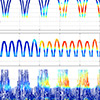
2017 THEMIS SCIENCE NUGGETS
SUMMARIES OF THEMIS RESEARCH
| <<View 2016 THEMIS Nuggets | Return to main page |
 Quintin Schiller, March 2017
Quintin Schiller, March 2017Simultaneous event-specific estimates of transport, loss, and source rates for relativistic outer radiation belt electrons
Concurrent transport, loss, and acceleration processes are detangled to model the radiation belts for a non-storm time enhancement event. Read more.
 Terry Liu, June 2017
Terry Liu, June 2017Statistical study of particle acceleration in the core of foreshock transients
Recent observations have also demonstrated that foreshock transients can accelerate particles which, when transported earthward, can affect space weather. Understanding the potential of foreshock transients to accelerate particles can help us understand shock acceleration at Earth and at other planetary and astrophysical systems. Read more.
 San Lu, July 2017
San Lu, July 2017The ion temperature gradient: An intrinsic property of Earth's magnetotail
Using multispacecraft observations of near-simultaneous plasma sheet crossings from 10 to 60 RE and three-dimensional global hybrid simulations, we demonstrate that the ion temperature ZGSM profile is bell-shaped at different geocentric distances. Read more.
 Marit Øieroset, July 2017
Marit Øieroset, July 2017THEMIS multispacecraft observations of a reconnecting magnetosheath current sheet with symmetric boundary conditions and a large guide field
Three THEMIS spacecraft have recorded the detailed plasma and field profiles in two diverging reconnection exhausts in a magnetosheath current sheet. The observed exhaust profiles suggest that THD observed an open-ended exhaust, while THE/THA crossed a magnetic island/flux rope between two active X-lines. Read more.
 Primož Kajdič, August 2017
Primož Kajdič, August 2017New type of foreshocks at Earth
The multi-spacecraft capabilities of the THEMIS and Cluster missions were used to show the existence of a new type of foreshock upstream of the Earth's quasi-parallel bow-shock called the traveling foreshock. These foreshocks are bounded by two rotational discontinuities in the interplanetary magnetic field and propagate along the bow-shock surface. Read more.
 Please send comments/suggestions to
Emmanuel Masongsong / emasongsong @ igpp.ucla.edu
Please send comments/suggestions to
Emmanuel Masongsong / emasongsong @ igpp.ucla.edu